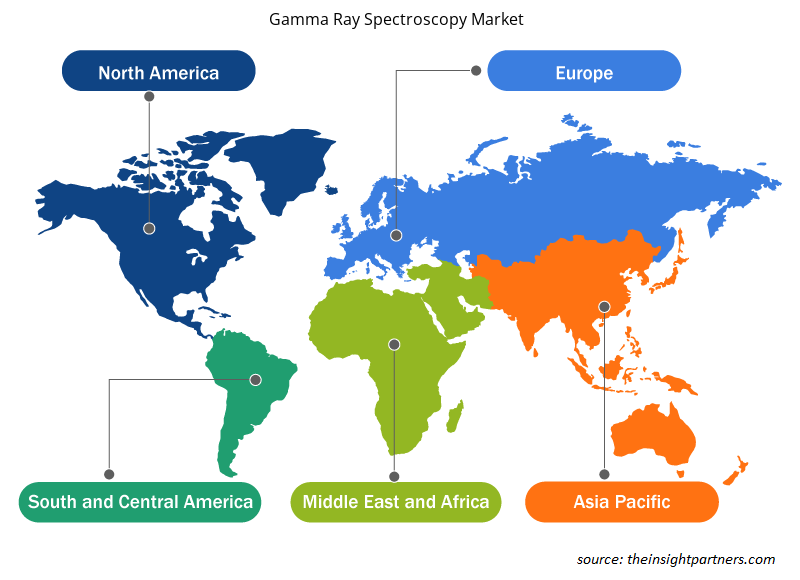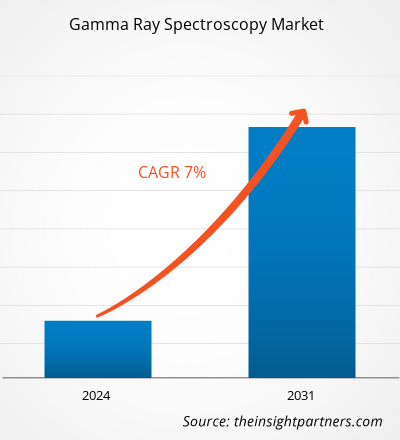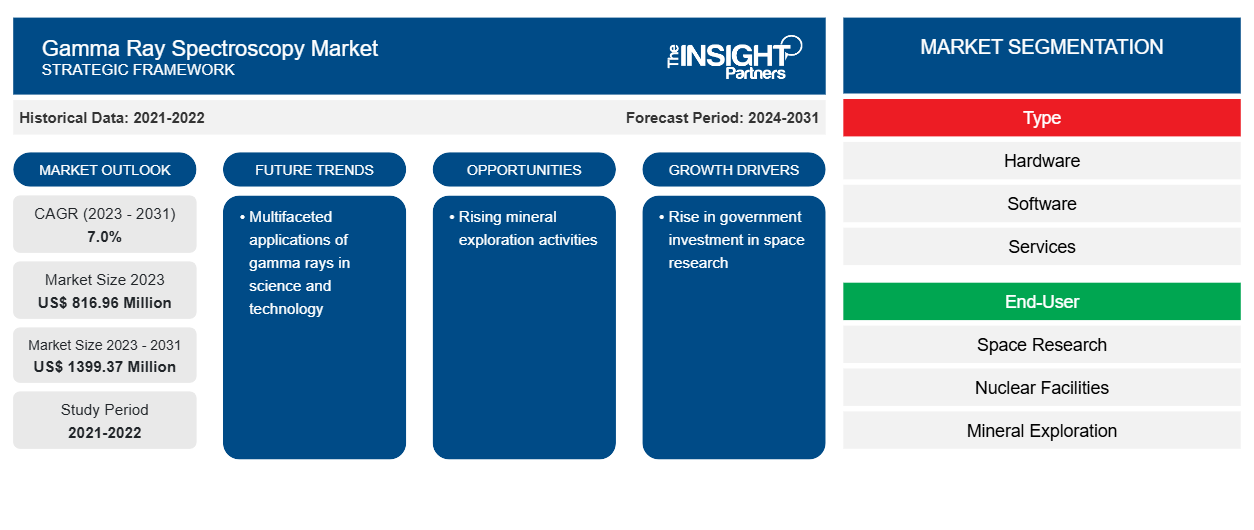Se prevé que el tamaño del mercado de espectroscopia de rayos gamma alcance los 1399,37 millones de dólares estadounidenses en 2031, frente a los 816,96 millones de dólares estadounidenses en 2023. Se espera que el mercado registre una CAGR del 7,0 % durante el período 2023-2031. Es probable que el aumento de la inversión gubernamental en actividades de investigación espacial y exploración minera siga siendo una tendencia clave en el mercado.
Análisis del mercado de espectroscopia de rayos gamma
El uso de un espectrómetro de rayos gamma para determinar la identidad y la cantidad de emisores gamma presentes en una fuente gamma conduce al crecimiento del mercado. Es una herramienta importante para el análisis de radioambiente y el análisis de pequeñas cantidades de materiales radiactivos. El creciente uso de la espectroscopia de rayos gamma para actividades de investigación y exploración espacial impulsa el crecimiento del mercado. Además, las actividades de exploración minera en todo el mundo fomentan aún más el crecimiento del mercado.
Descripción general del mercado de espectroscopia de rayos gamma
La espectrometría de rayos gamma se utiliza para determinar las propiedades cualitativas y cuantitativas de los radionucleidos que emiten radiación gamma. La espectrometría gamma tiene numerosas ventajas porque la preparación de la muestra para el análisis de radionucleidos es sencilla y, en la mayoría de los casos, no se requiere un procedimiento de separación radioquímica para el análisis. Además, los datos obtenidos por el sistema de detección son extremadamente adecuados para el procesamiento de datos por computadora, lo que los hace apropiados para el diseño de sistemas de análisis automáticos.
Personalice este informe según sus necesidades
Obtendrá personalización en cualquier informe, sin cargo, incluidas partes de este informe o análisis a nivel de país, paquete de datos de Excel, así como también grandes ofertas y descuentos para empresas emergentes y universidades.
-
Obtenga las principales tendencias clave del mercado de este informe.Esta muestra GRATUITA incluirá análisis de datos, desde tendencias del mercado hasta estimaciones y pronósticos.
Factores impulsores y oportunidades del mercado de la espectroscopia de rayos gamma
Inversión en investigación espacial
La espectroscopia de rayos gamma se utiliza ampliamente en la investigación espacial para determinar la composición elemental de las superficies de planetas, lunas y asteroides. Por ejemplo, el espectrómetro de rayos gamma (GRS) puede detectar los rayos gamma emitidos por los núcleos de los átomos en la superficie de Mercurio cuando los rayos cósmicos los golpean. Cuando los rayos cósmicos golpean elementos químicos en suelos y rocas, emiten firmas de energía identificables de forma única en forma de rayos gamma. Estos datos pueden ayudar a los científicos a buscar elementos geológicamente significativos como magnesio , hierro, hidrógeno, silicio, oxígeno, sodio, titanio y calcio. Por lo tanto, para este tipo de investigación, la demanda de espectroscopia de rayos gamma está aumentando. La inversión en investigación espacial impulsa la demanda de espectroscopia de rayos gamma. Por ejemplo, la NASA financia pequeñas empresas que las ayudan a investigar nuevas ideas y desarrollar soluciones innovadoras en aeronáutica, exploración humana, ciencia y tecnología espacial.
Aumento de las actividades de exploración minera.
En todo el mundo se está produciendo un aumento de las actividades de exploración minera, donde aumenta la demanda de espectroscopia de rayos gamma. Por ejemplo, la espectroscopia de rayos gamma se utiliza ampliamente en la exploración de uranio porque identifica directamente la presencia de elementos radiactivos naturales. Para dicha exploración minera, las autoridades gubernamentales invierten, lo que impulsa aún más el crecimiento del mercado. Por ejemplo, en julio de 2023, para facilitar la autosuficiencia en el frente de minerales críticos, el Ministerio de Minas anunció un incentivo financiero para la exploración, equivalente al 25% del costo del proyecto, tanto para agencias públicas como privadas.
Análisis de segmentación del informe de mercado de espectroscopia de rayos gamma
Los segmentos clave que contribuyeron a la derivación del análisis del mercado de espectroscopia de rayos gamma son el tipo y el usuario final.
- Según el tipo, el mercado de espectroscopia de rayos gamma se divide en hardware, software y servicios. El segmento de hardware tuvo la mayor participación de mercado en 2023.
- Por usuario final, el mercado se segmenta en investigación espacial, instalaciones nucleares y exploración minera. El segmento de exploración minera tuvo una participación significativa del mercado en 2023.
Análisis de la cuota de mercado de espectroscopia de rayos gamma por geografía
El alcance geográfico del informe de mercado de espectroscopia de rayos gamma se divide principalmente en cinco regiones: América del Norte, Asia Pacífico, Europa, Medio Oriente y África, y América del Sur y Central.
En 2023, Europa tendrá una importante cuota de mercado mundial. Según la Asociación Nuclear Mundial, la energía nuclear de Francia genera alrededor del 70% de la electricidad gracias a la política basada en la seguridad energética aprobada en 2014. Según esta política gubernamental, el país tenía como objetivo reducir la cuota nuclear de la producción de electricidad al 50% para 2025, fecha que se pospuso de 2019 a 2035. Además, en febrero de 2022, el país anunció su plan de construir 6 nuevos reactores nucleares. El desarrollo de reactores nucleares contribuirá aún más al mercado de la espectroscopia de rayos gamma en Europa.
Perspectivas regionales del mercado de espectroscopia de rayos gamma
Los analistas de Insight Partners explicaron en detalle las tendencias y los factores regionales que influyen en el mercado de espectroscopia de rayos gamma durante el período de pronóstico. Esta sección también analiza los segmentos y la geografía del mercado de espectroscopia de rayos gamma en América del Norte, Europa, Asia Pacífico, Oriente Medio y África, y América del Sur y Central.

- Obtenga datos regionales específicos para el mercado de espectroscopia de rayos gamma
Alcance del informe de mercado de espectroscopia de rayos gamma
| Atributo del informe | Detalles |
|---|---|
| Tamaño del mercado en 2023 | US$ 816,96 millones |
| Tamaño del mercado en 2031 | US$ 1399,37 millones |
| CAGR global (2023 - 2031) | 7.0% |
| Datos históricos | 2021-2022 |
| Período de pronóstico | 2024-2031 |
| Segmentos cubiertos |
Por tipo
|
| Regiones y países cubiertos |
América del norte
|
| Líderes del mercado y perfiles de empresas clave |
|
Densidad de actores del mercado: comprensión de su impacto en la dinámica empresarial
El mercado de espectroscopia de rayos gamma está creciendo rápidamente, impulsado por la creciente demanda de los usuarios finales debido a factores como la evolución de las preferencias de los consumidores, los avances tecnológicos y una mayor conciencia de los beneficios del producto. A medida que aumenta la demanda, las empresas amplían sus ofertas, innovan para satisfacer las necesidades de los consumidores y aprovechan las tendencias emergentes, lo que impulsa aún más el crecimiento del mercado.
La densidad de actores del mercado se refiere a la distribución de las empresas o firmas que operan dentro de un mercado o industria en particular. Indica cuántos competidores (actores del mercado) están presentes en un espacio de mercado determinado en relación con su tamaño o valor total de mercado.
Las principales empresas que operan en el mercado de espectroscopia de rayos gamma son:
- CAEN S.A.
- Tecnologías Mirion, Inc.
- AMETEK Inc
- Linde S.A.
- Sander Geofísica Limitada
- Instrumentos NUVlATech
Descargo de responsabilidad : Las empresas enumeradas anteriormente no están clasificadas en ningún orden particular.

- Obtenga una descripción general de los principales actores clave del mercado de espectroscopia de rayos gamma
Noticias y desarrollos recientes del mercado de espectroscopia de rayos gamma
El mercado de espectroscopia de rayos gamma se evalúa mediante la recopilación de datos cualitativos y cuantitativos posteriores a la investigación primaria y secundaria, que incluye publicaciones corporativas importantes, datos de asociaciones y bases de datos. A continuación, se enumeran algunos de los desarrollos en el mercado de espectroscopia de rayos gamma:
- El espectrómetro de rayos gamma (GRS) de la misión, ubicado a 2 metros de la nave espacial Psyche de la NASA en la punta de un brazo, cobró vida en noviembre de 2023 por primera vez desde su lanzamiento a mediados de octubre. El GRS es la mitad del instrumento del espectrómetro de rayos gamma y neutrones (GRNS) de la misión Psyche. Los datos se recopilaron como parte de un conjunto de actividades muy bien orquestadas que se han planificado y ensayado cuidadosamente durante los últimos tres años. (Fuente: The Johns Hopkins University Applied Physics Laboratory LLC, comunicado de prensa, diciembre de 2023)
Cobertura y resultados del informe de mercado de espectroscopia de rayos gamma
El informe "Tamaño y pronóstico del mercado de espectroscopia de rayos gamma (2021-2031)" proporciona un análisis detallado del mercado que cubre las siguientes áreas:
- Tamaño del mercado de espectroscopia de rayos gamma y pronóstico a nivel mundial, regional y nacional para todos los segmentos clave del mercado cubiertos bajo el alcance
- Tendencias del mercado de espectroscopia de rayos gamma, así como dinámica del mercado, como impulsores, restricciones y oportunidades clave
- Análisis detallado de las cinco fuerzas de Porter y PEST y FODA
- Análisis del mercado de espectroscopia de rayos gamma que abarca las tendencias clave del mercado, el marco global y regional, los principales actores, las regulaciones y los desarrollos recientes del mercado
- Panorama de la industria y análisis de la competencia que abarca la concentración del mercado, análisis de mapas de calor, actores destacados y desarrollos recientes para el mercado de espectroscopia de rayos gamma
- Perfiles detallados de empresas
- Análisis histórico (2 años), año base, pronóstico (7 años) con CAGR
- Análisis PEST y FODA
- Tamaño del mercado, valor/volumen: global, regional y nacional
- Industria y panorama competitivo
- Conjunto de datos de Excel
Informes recientes
Testimonios
Razón para comprar
- Toma de decisiones informada
- Comprensión de la dinámica del mercado
- Análisis competitivo
- Información sobre clientes
- Pronósticos del mercado
- Mitigación de riesgos
- Planificación estratégica
- Justificación de la inversión
- Identificación de mercados emergentes
- Mejora de las estrategias de marketing
- Impulso de la eficiencia operativa
- Alineación con las tendencias regulatorias























 Obtenga una muestra gratuita para - Mercado de espectroscopia de rayos gamma
Obtenga una muestra gratuita para - Mercado de espectroscopia de rayos gamma